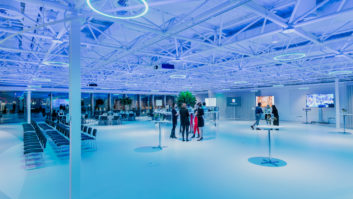
Luke Mahler-Hausen, AV and live business development manager, Blackmagic Design reveals the ways clubs are using AV technology to improve fan engagement through content production.
What impact has the trend of stadiums investing in broadcasting equipment to create their own content had for Blackmagic?
Many sports clubs are already embracing the idea that they as brands can become content producers, not least because it serves to deepen engagement with fans and supporters. In fact, it also creates new commercial opportunities, which for sports that lack big money television contracts, can be hugely successful in driving money back into the development of a sport and talent, while also broadening access and reach.
All of this translates into need for stadiums and clubs to invest in their AV production capabilities not only to deliver content to big screens for match day spectators, but also produce the variety and volume of content needed to feed social channels and live streams. Effectively, the stadium’s AV system is now the hub for all of that content production, and has to be flexible enough to handle multiple channels for a range of audiences.
How are stadiums using AV technology to improve fan engagement and the match day experience?
Without a doubt, there has been a massive increase in all aspects of distribution: clubs are doing more than ever to enhance the match day experience, producing additional content, whether that be interviews with players and pundits or special entertainment packages and live music. Fans are hungrier than ever for content, and it’s down to the clubs to make it as easy as possible to find and access.
If you turn back the clock, once a fan walked in through the ticketing gate he or she was yours for the entirety of the day. That is no longer the case. Smartphones, and better, high speed mobile coverage means that fans aren’t the captive audience they once were. Clubs are seeing that and realising that in order to keep audiences engaged they’ve got to be producing great content throughout the day. AV is very much part of the ‘match day experience’ rather than a layer in itself.
What are the extra considerations you have for a stadium project if it’s a multi-use venue as opposed to those used exclusively for one sport?
As well as the usual challenges in a stadium system, such as managing signal integrity over distance, ensuring those systems can handle different requirements from staging partners is a must. Amsterdam ArenA (pictured) is a great example. Not only does it support the media arm of Ajax Football Club, it also has to deal with more than 400 corporate events and major concerts over the course of a year.
If the customer also wants to manage content creation across all of the events taking place in the venue, or add revenue from online VOD or streaming services, they will also need to consider media storage and asset management from live camera feeds. Typically, this can be scaled up from dedicated encoders attached to production switchers for direct live streaming through to a full post-production workflow, allowing customers to craft and deliver rich media content access across a number of platforms.
What makes the difference between a profitable stadium project and an unprofitable one?
Consulting with an experienced systems integration partner or AV consultant in the early stages of any project will go a long way to ensuring stadiums and venues are investing in the right solutions. And of course, future proofing systems will always be a key factor to the long term profitability of any installation.






